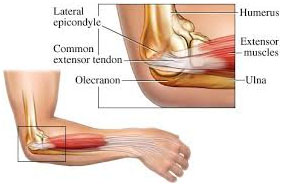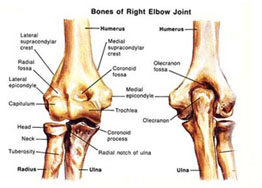Elbow
The elbow is the joint where three long bones meet in the middle portion of the arm. The bone of the upper arm (humerus) meets the inner bone of the forearm (ulna) and the outer bone of the forearm (radius) to form a hinge joint. The radius and ulna also meet in the elbow to allow for rotation of the forearm. The elbow functions to move the arm like a hinge (forward and backward) and in rotation (twisting outward and inward). The biceps muscle is the major muscle that flexes the elbow hinge. The triceps muscle is the major muscle that extends the elbow hinge. The outer bone of the elbow is referred to as the lateral epicondyle and is a part of the humerus bone. Tendons are attach to this area which can be injured, causing inflammation ortendinitis (lateral epicondylitis, or "tennis elbow"). The inner portion of the elbow is a bony prominence called the medial epicondyle. Additional tendons from the muscles attach here and can be injured, causing medial epicondylitis, "golfer's elbow." A fluid-filled sac (bursa), which serves to reduce friction, overlies the tip of the elbow (olecranon bursa). The elbow can be affected by inflammation of the tendons or the bursae (plural for bursa), or conditions that affect the bones and joints, such as fractures, arthritis, or nerve irritation.
What injuries can cause elbow pain?
Tendinitis
Lateral Epicondylitis (Tennis Elbow)

The lateral epicondyle is the outside bony portion of the elbow where large tendons attach to the elbow from the muscles of the forearm. These tendons can be injured, especially with repetitive motions of the forearm, such as using a manual screwdriver, washing windows, or hitting a backhand in tennis play. Tennis elbow results with inflammation of the tendons causing pain over the outside of the elbow, occasionally with warmth and swelling, but always with local tenderness. The elbow maintains its full range of motion, as the inner joint is not affected, and the pain can be particularly noticed toward the end of the day. Repeated twisting motions or activities that strain the tendon typically elicit increased pain. X-rays are usually normal, but can reveal calcium deposits in the tendon or reveal other unforeseen abnormalities of the elbow joint.
The treatment of tennis elbow includes ice packs, resting the involved elbow, and anti-inflammatory medications. Anti-inflammatory drugs typically used include aspirin and other nonsteroidal antiinflammatory drugs. Bracing the elbow can help. Simple braces for tennis elbow can be found in community pharmacies and athletic goods stores. Local cortisone injections are given for persistent pain. Activity involving the elbow is resumed gradually. Ice application after activity can reduce or prevent recurrent inflammation. Occasionally, supportive straps can prevent reinjury. In severe cases, an orthopedic surgical repair is performed.
Medial Epicondylitis (Golfer's Elbow)

Medial epicondylitis is inflammation at the point where the tendons of the forearm attach to the bony prominence of the inner elbow. As an example, this tendon can become strained in a golf swing, but many other repetitive motions can injure the tendon. Golfer's elbow is characterized by local pain and tenderness over the inner elbow. The range of motion of the elbow is preserved because the inner joint of the elbow is not affected. Those activities which require twisting or straining the forearm tendon can elicit pain and worsen the condition. X-rays for epicondylitis are usually normal but can indicate calcifications of the tendons if the tendinitis has persisted for extended periods of time.
The usual treatment involves ice packs, resting the elbow, and medications including aspirin and other NSAIDs.With severe inflammation, local corticosteroid (cortisone ) injections are sometimes given. Using a strap can prevent reinjury. After a gradual rehabilitation exercise program, return to usual activity is best accompanied by ice applications after use. This helps to avoid recurrent inflammation.
